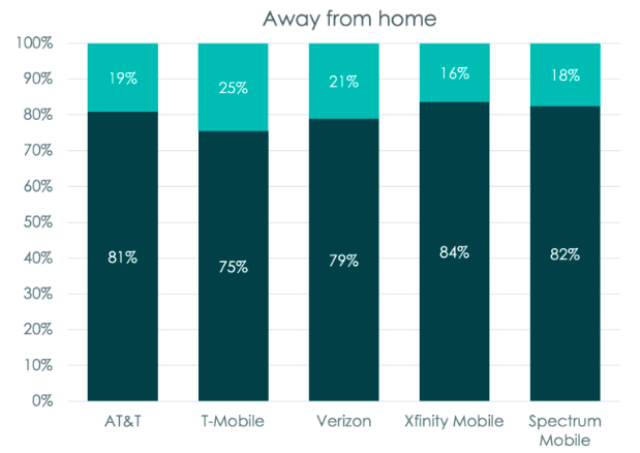U.S. mobile users, despite having access to unlimited data plans, still favor Wi-Fi for data-intensive tasks, the latest Opensignal report said. The majority of data transfer occurs over Wi-Fi, especially at home and work, where the signal strength is typically better.

Many cable MVNO (Mobile Virtual Network Operator) users, such as those on Spectrum Mobile and Xfinity Mobile, are on capped data plans. This encourages more frequent Wi-Fi usage to avoid exceeding data limits.
Xfinity Mobile and Spectrum Mobile users consume more data over Wi-Fi compared to the three main MNOs (Mobile Network Operators) — T-Mobile, Verizon, and AT&T. This is part of Comcast’s and Charter’s strategy to reduce cellular traffic costs through extensive in-home and public Wi-Fi hotspots.

Users generally default to Wi-Fi when at home, and a significant portion of mobile screen time is spent at home. Cable MVNO users, who must have broadband subscriptions for mobile access, exhibit higher at-home usage. In contrast, T-Mobile users utilize mobile data more heavily when away from home due to wider 5G availability and limited Wi-Fi hotspots.
While 5G speeds can rival fixed broadband, Wi-Fi remains dominant for most users. Distinctions exist between providers: cable MVNOs focus on Wi-Fi offload, while T-Mobile has higher mobile usage. With MVNOs building limited cellular infrastructure and T-Mobile expanding broadband, future trends in network usage could evolve, Rupert Bapty, Andrey Popov (authors), and Francesco Rizzato (technical data) said.
Why mobile users prefer Wi-Fi?
Data-Intensive Tasks
Wi-Fi is often preferred for tasks that require substantial downloading and uploading, such as streaming high-definition videos, gaming, or large file transfers. Even with unlimited data plans, users tend to rely on Wi-Fi for these activities due to the faster speeds and stability Wi-Fi often provides.
Signal Strength and Speed
Wi-Fi offers better signal quality indoors, whether at home or at work, which enhances connectivity and speeds, especially in areas where mobile network signals may be weaker.
Data Caps on Some Plans
Many users, particularly those on cable MVNOs like Spectrum Mobile and Xfinity Mobile, are on data-capped plans, which limit the amount of mobile data they can use without incurring extra fees. As a result, they have an incentive to use Wi-Fi where available to avoid data overages.
Proactive Wi-Fi Offload Strategies by MVNOs
Cable providers like Comcast and Charter encourage users to use Wi-Fi by providing extensive networks of in-home Wi-Fi and public hotspots. This approach not only improves users’ broadband experience but also reduces the costs of cellular network usage for these MVNOs.
Higher Time Spent at Home
The majority of mobile use happens at home, where users typically have access to high-speed Wi-Fi. Around 75 percent of phone usage time is reported to be at home, so users naturally default to Wi-Fi, which is generally more consistent and faster for indoor use.
5G Limitations and Cost Efficiency
While modern 5G networks offer high speeds, Wi-Fi still tends to be the go-to choice for most users. Cable MVNO subscribers are particularly inclined to favor Wi-Fi, while T-Mobile users — who have broader 5G availability — may rely more on mobile data outside the home.
Baburajan Kizhakedath
